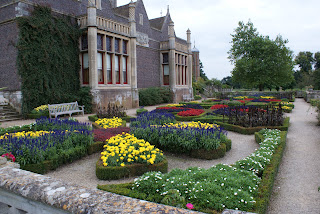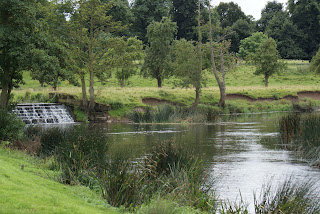My association with Charlecote Park spans just a handful of years, yet my connection and fascination is as deep rooted as if I'd grown up there. Very odd indeed, for I only ever venture past the picturesque park paling as a visitor. The National Trust hold an array of properties, many being estates that were initially built around the needs of one family or another; each has its own identity and is unique in some way. Charlecote is of course unique, just like the rest - if that makes sense?!
 |
| Gatehouse, Charlecote Park 2009. Gary Webb. |
Prior to moving to a village just ten minutes from the Griffin topped gate piers of Charlecote, I'd heard only of the substantial parkland and its age old and distinctive deer fencing, constructed to keep the fallow deer and rare breed Jacob sheep in. Since settling in the area however, I've come to learn not only of the finer points of the property itself, but also of a wider area that is rich in historical visitor attractions. Indeed, if Charlecote Park is at the heart of a map, its historical connections spread like veins to many other locations in the county and beyond - no doubt, these 'attractions' of today were once the nearest wealthy landowners, neighbours of sorts - the Greville's of Warwick Castle, and the Verney's of Compton Verney for example.
I guess for me, it wasn't until I read the book 'Mistress Of Charlecote: The Memoirs of Mary Elizabeth Lucy, 1803-1889', drawn together by Alice Fairfax-Lucy, that the property as a whole really started to make sense. The property today, whilst still home to the donor family, is a thriving and well visited tourist location situated just a few miles from Stratford upon Avon. The parkland is a magnet for those visitors who like a longer stroll in olde-world surroundings, amongst deer, and of course there is the stunning mansion with obligatory NT shop and cafe, the latter being shoe-horned into an otherwise handsome orangery.
 |
| Charlecote Park, taken whilst on a Deer Park Safari 2009. Gary Webb. |
 |
| Parterre/River Terrace, 2008. Gary Webb. |
Whilst the book brought certain elements to life for me, my imagination finds it easy to do the rest, if I may dream for a moment: In the courtyard, with fine-looking carriages tucked behind solid timber doors, I sometimes sit towards the end of a day, and across the cobbles I visualise one of the gentlemen climbing onto a horse before riding out to visit tenant farmers. Leaning against solid Tudor brickwork inside the brew house, I feel the lost warmth from the fires and can almost smell the malt brought in for brewing in those huge copper pans. And, last but not least, when I stand in the great hall before the large estate painting, I can almost stroll along those raked gravel walks, with pots of neatly clipped evergreens and views out through avenues to the distant Warwickshire hills.
 |
| Woodland/Wilderness Garden, Charlecote Park. 2009. Gary Webb |
 |
| River Avon and cascade at Charlecote Park. 2009. |
 |
| Charlecote Park, Mary Elizabeth Lucy's Summerhouse. 2008. Gary Webb. |
In no way have I attempted to tell the full story of Charlecote, for it is so heavy with history that a hefty book would be needed to serve justice. In this post I've attempted to exhibit the elements that reach out to me as someone fascinated in the estate, the buildings, their history, and of course the gardens. I haven't found the space to write about the Victorian Kitchens, where the range is regularly lit for demonstrations, and neither have I spoke about the notable tree collection. There's the Jacob sheep, and the story of their arrival at Charlecote, and of the modernisation of the house in the Tudor taste, I could continue. If you're in the slightest way intrigued by social and family history, architecture, gardens or the country estate, then I hope my post will inspire you to visit and enjoy the ambiance that Charlecote has in abundance.
 |
| Charlecote Park, Jacob Sheep, 2009. Gary Webb. |
Links:
Charlecote Park (National Trust.)
Charlecote Park - Wikipedia
@CharlecoteNT
Warwick Castle - Wikipedia
Compton Verney - Wikipedia
2 comments:
Great post. I can tell you are smitten by the place! It's funny how some places get you, even though you're not always sure why they should. As I think I've mentioned, I love Fisherwick in Staffordshire, another Capability Brown landscape. There's so little left though my imagination has to go into overdrive. I will have to visit Charlecote, it's not too far and I am a Warwickshire lass by birth! Best wishes,Kate
I think that is the beauty of historic gardens and landscapes, even if they have been 'restored' to a particular time period, and even if they are a true reflection of how the place once looked, there is still scope for us to imagine. We can still wonder how the gardeners once toiled with simple tools, how the owners played in the garden, and how all the people in a distant time would have felt, when attitudes and feeling were very different. Unforunately, whichever garden I'm looking at leaves me feeling I am 100 years+ too late to really appreciate it!
Fisherwick is high on my agenda to visit, and Charlecote, for yourself as a Warwickshire lass is a must see!I'm sure you won't be dissapointed.
Thanks for the comment, much appreciated.
Gary
Post a Comment